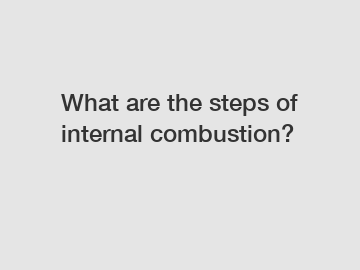What are the steps of internal combustion?
What are the steps of internal combustion?
Internal combustion is the process by which fuel is burned inside an engine to produce power. It is a fundamental concept in the field of mechanical engineering and plays a crucial role in our everyday lives. Whether it's the car we drive or the lawnmower we use, internal combustion engines are all around us. But how exactly does this process work? In this article, we will explore the steps of internal combustion and gain a deeper understanding of this remarkable technology.
1. Intake Stroke:

The first step in internal combustion is the intake stroke. During this process, the piston moves downwards in the cylinder, creating a vacuum. The intake valve opens, allowing a mixture of fuel and air to enter the cylinder. This mixture is crucial for combustion and contains the right proportions of fuel (such as gasoline or diesel) and air to ensure optimal performance.
2. Compression Stroke:
After the intake stroke, the piston moves back up, compressing the fuel-air mixture. This compression increases the pressure and temperature inside the cylinder, making the mixture highly combustible. It is during this phase that the spark plug, located at the top of the cylinder, ignites the compressed fuel-air mixture.
3. Power Stroke:
The ignition of the compressed fuel-air mixture triggers an explosion, resulting in a rapid expansion of gases. This expansion pushes the piston forcefully downwards, generating power. This stroke is called the power stroke since it is the main contributor to the engine's output of work or torque.
4. Exhaust Stroke:
Once the power stroke is complete, the piston moves back up, expelling the exhaust gases generated during combustion. The exhaust valve opens, allowing the gases to exit the cylinder and be released into the atmosphere through the exhaust system. This stroke completes the cycle, preparing the engine for the next intake stroke to repeat the process.
Internal combustion engines follow these steps in a continuous cyclic manner, with each cylinder going through four strokes over and over again. This repeating cycle is what enables the engine to produce the power necessary to propel our vehicles and perform various mechanical tasks.
The efficiency and performance of an internal combustion engine depend on several factors. Key among them is the fuel-air mixture ratio, which needs to be carefully controlled. Too much fuel can lead to inefficient combustion and increased emissions, while too little fuel can result in decreased power output.
Furthermore, advancements in technology have led to the development of various engine designs and fuel types. Over the years, gasoline and diesel engines have been widely used, but alternative fuels such as electricity and hydrogen are gaining popularity. The steps of internal combustion remain the same, but the fuel and combustion process may differ based on the engine type.
In conclusion, internal combustion is a complex, yet fascinating process that powers the engines we use every day. From cars to lawnmowers and everything in between, this technology has revolutionized the way we live and work. Understanding the steps of internal combustion provides us with insight into the inner workings of these engines and highlights the importance of efficient fuel consumption. As we continue to explore cleaner and more sustainable energy sources, the principles of internal combustion will undoubtedly play a crucial role in shaping the future of transportation and power generation. So next time you turn on your car or fire up your lawnmower, take a moment to appreciate the incredible steps of internal combustion that make it all possible.
Are you interested in learning more about 1.5 Ton Stand Type Electric Reach Truck, 4 Directional Reach Truck, 1 Ton AGV Tri-Lateral Electric Forklift? Contact us today to secure an expert consultation!

Comments